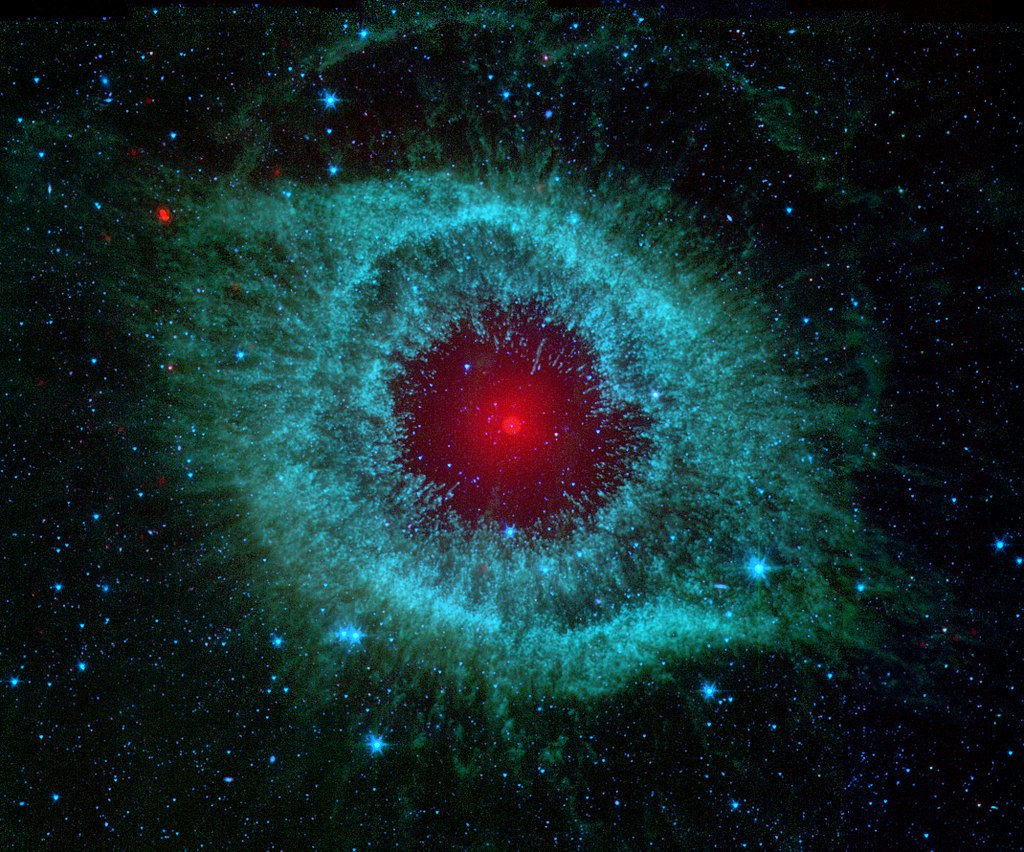
Clearly, the Helix nebula brings up strong reactions in everyone who sees it! And at a brightness magnitude of 7.6, it is a popular choice for amateur astronomers because it is relatively easy to spot without advanced knowledge or training.
The classification of the Helix nebula as a “planetary nebula” is one that was coined in the 18th century by an astronomer named William Herschel. Long ago before telescopes were of sufficient strength to help astronomers distinguish between planets and nebula. So originally, astronomers thought the Helix nebula and others like it were planets!
At its center is a dying star called a white dwarf star. Today, the white dwarf star that sits in the very center of the Helix nebula is about the size of the Earth but the entire structure has a mass much greater than Earth.
Surrounding the remains of the star itself are bands of gaseous matter. This is why photographs of the Helix nebula often make it look so colorful and so different from frame to frame. Different lens filters, from infrared to ultraviolet and others, can be applied to study different gaseous bands and properties.
Helix Nebula Profile
This data gives a basic overview of the composition of the nebula.
Designation: Helix Nebula or NGC (New General Catalog) 7293
Type: Planetary nebula
Diameter: 2.87 light years
Distance: 655 light years
Mass: 0.93 M
Constellation: Aquarius
Facts And Features
- The Helix Nebula is estimated to be about 10,600 years old.
- Before the explosion that created the Helix Nebula, it is highly likely that a system of planets, natural interstellar moons, comets and other celestial objects orbited around the star in a way quite similar to how Earth and the other planets orbit around the Sun.
- One of the most interesting aspects of the nebula for astronomers is that inside its gaseous bands are surviving comets. This very rarely happens once a dying star explodes.
- When observed through binoculars or a telescope, the nebula itself is often likened to the size of one-half a full Moon. The glow that surrounds the nebula is caused by the ionizing impact of radiation being emitted by the dying star.
- In about 5 billion years from now, the Sun will also go through its red giant phase, explode, and from that explosion enter its planetary nebula phase. Burning off the surrounding gaseous bands as fuel until it dies out completely.
- The Helix Nebula was originally discovered by a German astronomer named Karl Ludwig Harding. He discovered many other celestial objects in addition to this nebula. It is now thought that Harding made his discovery of the Helix Nebula before 1824, but the precise date is not known.
- The Helix Nebula formed when a massive red giant star exploded, resulting in the white dwarf star at the nebula center that is now surrounded by continuously expanding bands of gases and dust.
- While the nebula definitely appears to be a circular shape when viewed through a telescope, astronomers now believe it is actually more elongated. The reason Earth viewers don’t see the elongation is because of the way the Helix Nebula faces Earth. If viewed from the side (away from Earth) the extended shape would become visible.
- The Helix Nebula is so vast that Hubble telescope cameras had to take several separate photos to capture its full extent. The Hubble’s operators then had to assemble the different photos together to get a more complete picture of the nebula. They then combined that photo together with another wide-angle photo taken at the Kitt Observatory and only then could they see the entire mass of the nebula.
- Right now, the Helix Nebula is still incredibly hot and very active as the gaseous bands are used for fuel and burned away one by one. As this process continues, the entire structure will eventually cool.
- The outermost gaseous bands are composed mostly of lighter gases like hydrogen and helium. Nearer the center are the heavier gases like oxygen, nitrogen and carbon. All of these gases are fuel sources that will eventually be exhausted one after another. When this happens, the star will die out completely.
- Long filaments of hydrogen called “knots” extend outward from the center of the nebula like spokes on a bicycle wheel. Each one of these knots on its own is the size of the entire solar system that surrounds Earth. It is estimated there are around 20,000 such knots inside the nebula. However, astronomers are still trying to figure out what caused the knots to form. And in fact, the Helix Nebula is the first planetary nebula in which knots were discovered.
- The entire nebula is constantly being buffeted by strong solar winds that push at the gaseous bands and cause the nebula structure to expand. Right now, the nebula’s innermost gaseous bands are expanding at an estimated rate of 31 km per second. The outermost gaseous bands are expanding at an estimated rate of 40 km per second.
- On dark nights, it is often possible to observe the Helix nebula with a pair of good binoculars. However, a telescope is needed to view the gaseous bands that surround the central white dwarf star.
image source:
- By NASA/JPL-Caltech/Univ. of Ariz. – NASA – Comets Kick up Dust in Helix Nebula, Public Domain, https://commons.wikimedia.org/w/index.php?curid=1669175